Exchange Building and Petersburg Siege Museum
Introduction
Text-to-speech Audio
Images
With its columns and white exterior, the Exchange Building is a beautiful example of Greek Revival architecture. Photo by Petersburg Museums.
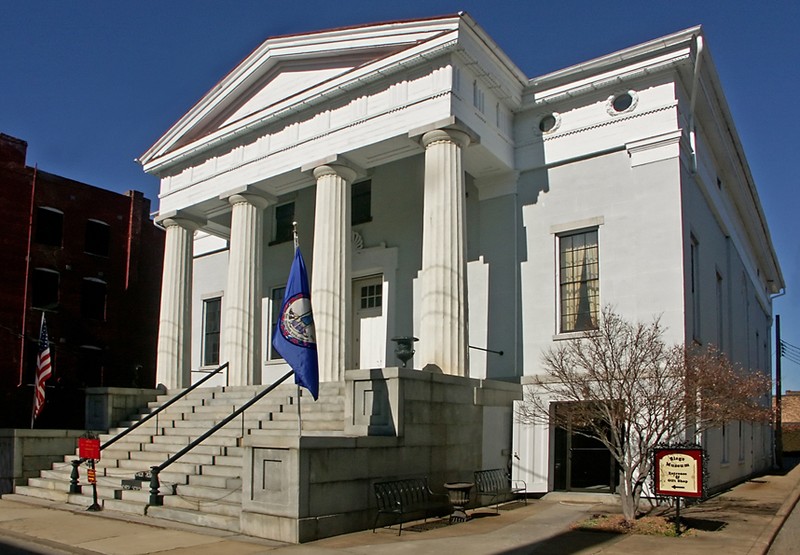
The Historic American Buildings Survey (HABS) documents architectural measurements, as shown here in this drawing.
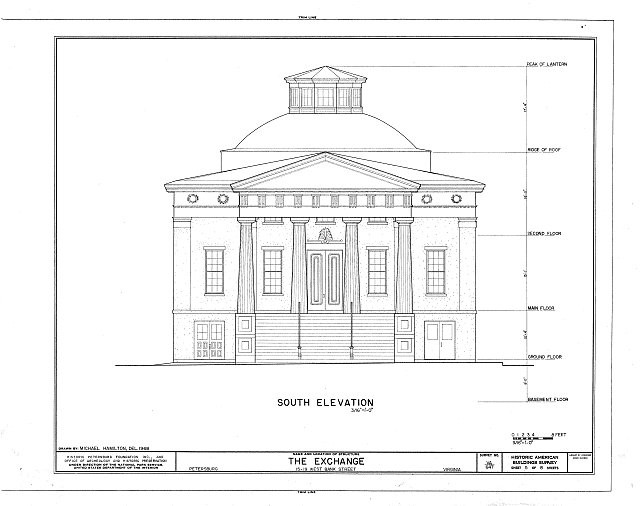
Photo of the Exchange Building serving as the police station in 1959. Photo by HABS.
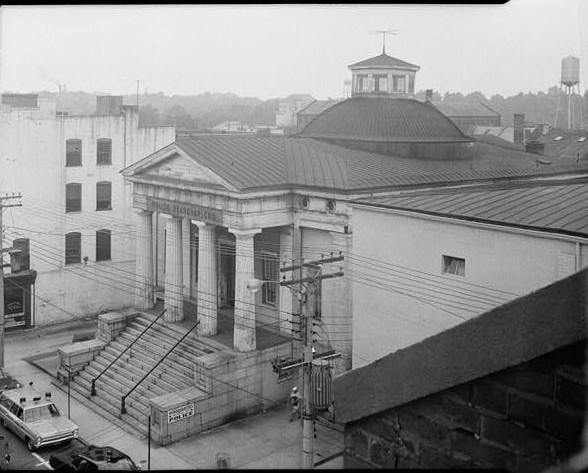
Greek Revival architecture makes an impressive statement and often appears in city buildings. Photo by HABS.
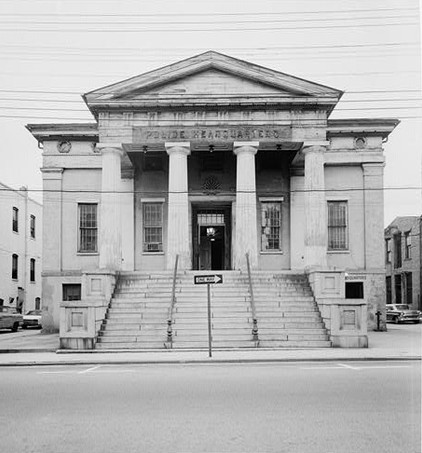
Henry Elebeck advertises his business in the Exchange Building in 1855. From the Library of Virginia.
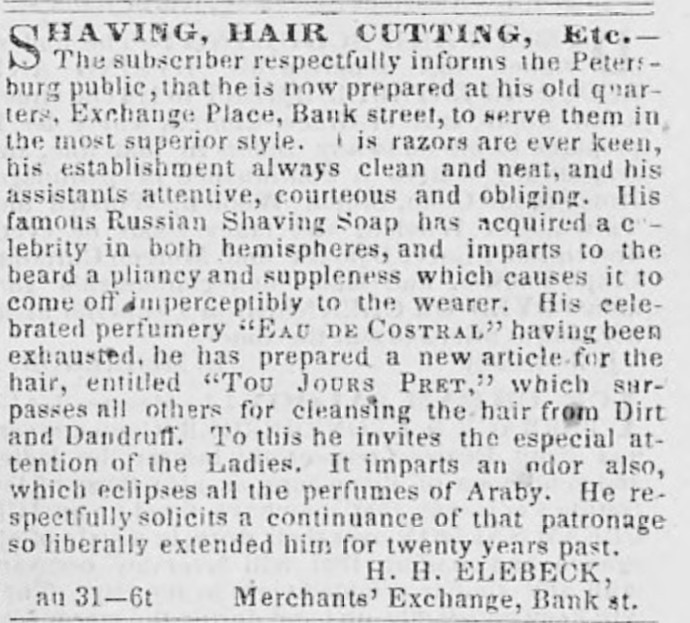
Exchange Building in 1842
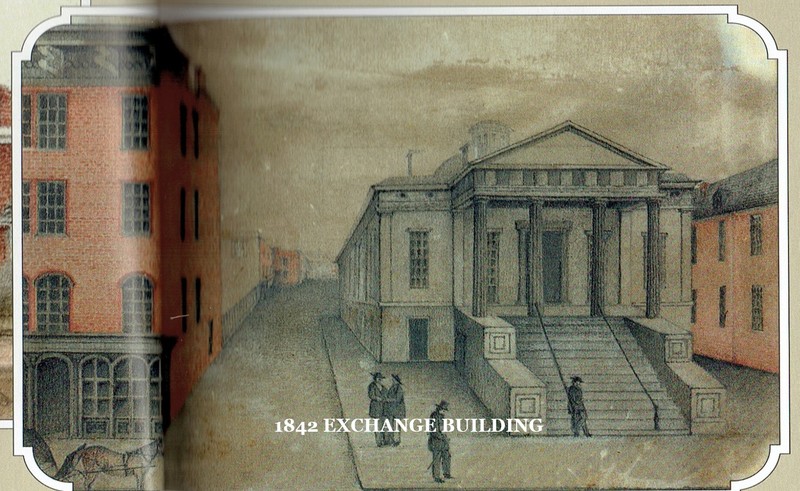
Backstory and Context
Text-to-speech Audio
The Exchange Building is best distinguished by its Greek Revival architecture. Outside, tall, imposing columnns support a portico, or roof covering a porch. Through the front doors, the space opens into a circular, domed room. These features harken back to architecture found in temples of ancient Greece, the birthplace of democracy. In the United States, Greek Revival architecture was used in government buildings, banks, and courthouses, a popular way to identify the "temples" of American ideals in the mid-nineteenth century. Greek Revival was first brought to the United States by Benjamin Henry Latrobe, one of the architects of the Capitol in Washington, D.C.3
Over time, the Exchange Building served a number of purposes for downtown Petersburg. It functioned as a bank, a commodities wholesaler for tobacco, cotton, and grain, an office space for lawyers, newspapers, and police, a series of shops, and a Juvenile and Domestic Court. One story from the Exchange Building is of Henry Elebeck, a free man of color who owned a barber shop in the building. Situated in Petersburg's main commercial district, Elebeck's business strategically tapped into a market of wealthy visitors conducting business in the Exchange Building. At the same time, white citizens found barbering an undesirable trade, and free men of color, like Elebeck, filled this niche. As L. Diane Barnes wrote, "In a region where dark skin designated servitude and bondage, free African Americans challenged the expectations of white society."4 The Exchange Building, built by tobacco planters and occupied by diverse occupations, reveals a complex history of commerce in Petersburg.
Since the 1970s, the Exchange Building has been home to the Siege Museum, which interprets the history of civilian life in the Civil War. As the second largest city in Virginia during the Civil War, Petersburg endured efforts to cut off supply lines and capture the city. Though not formally a siege, the ten months of fighting is often called the Siege of Petersburg. In 1864, it was at the Exchange Building that militiamen were called to fight in the First Battle of Petersburg, also known as the Battle of Old Men and Young Boys. The museum looks at how civilians lived their lives at the center of these conflicts.5 Today, the museum preserves these stories and the beautiful building that witnessed it.
Sources
1. National Park Service, "Petersburg Old Town Historic District," National Register of Historic Places; Barnes, Artisan Workers in the Upper South, 18-22.
2. Barnes, Artisan Workers in the Upper South, 22.
3. Poppeliers and Chambers, What Style is it?, 39-45.
4. Barnes, Artisan Workers in the Upper South, 135-138.
5. "The Exchange Building," Petersburg Museums.
Barnes, L. Diane. Artisan Workers in the Upper South: Petersburg, Virginia, 1820-1865. Baton Rouge: Louisiana State University Press, 2008.
Barnes, L. Diane. "David Dunlop (1804–1864)." Dictionary of Virginia Biography. Library of Virginia, 2016. Accessed September 2017. http://www.lva.Virginia.gov/public/dvb/bio.asp?b=Dunlop_David_1804-1864
Elebeck, Henry. "Shaving, Hair Cutting, etc." Advertisement. Daily Express, Volume 4, Number 209, 3 September 1855. From Virginia Chronicle, Library of Virginia. http://Virginiachronicle.com/cgi-bin/Virginia?a=d&d=TDE18550903.1.2
"The Exchange Building." Petersburg Museums. Accessed September 2017. http://preservationpetersburg.org/museums/siege/
National Park Service. "Exchange, 15-19 West Bank Street, Petersburg, VA." Historic American Buildings Survey. Prepared by James C. Massey and Randall J. Biallas. Washington, D.C.: National Park Service, U.S. Department of the Interior, 1959. From Prints and Photographs Division, Library of Congress (HABS VA-647) https://loc.gov/pictures/item/va0354/National Park Service. "Exchange Building." National Register of Historic Places Inventory-Nomination Form. Prepared by Virginia Historic Landmarks Commission staff. Washington, D.C.: National Park Service, U.S. Department of the Interior, 1969. https://npgallery.nps.gov/pdfhost/docs/NHLS/Text/69000322.pdf
National Park Service. "Farmers Bank." National Register of Historic Places Inventory-Nomination Form. Prepared by Virginia Historic Landmarks Commission staff. Washington, D.C.: National Park Service, 1972. http://www.dhr.Virginia.gov/registers/Cities/Petersburg/123-0067_Farmer's_Bank_1972_Final_Nomination...
National Park Service. "Petersburg Old Town Historic District." National Register of Historic Places Inventory-Nomination Form. Prepared by Virginia Historic Landmarks Commission staff. Washington, D.C.: National Park Service, U.S. Department of the Interior, 1980. http://www.dhr.Virginia.gov/registers/Cities/Petersburg/123-0097_Petersburg_Old_Town_HD_Final_Nomina...
Poppeliers, John C. and S. Allen Chambers, Jr. What Style is it? A Guide to American Architecture. John C. Wiley and Sons: 2003.
